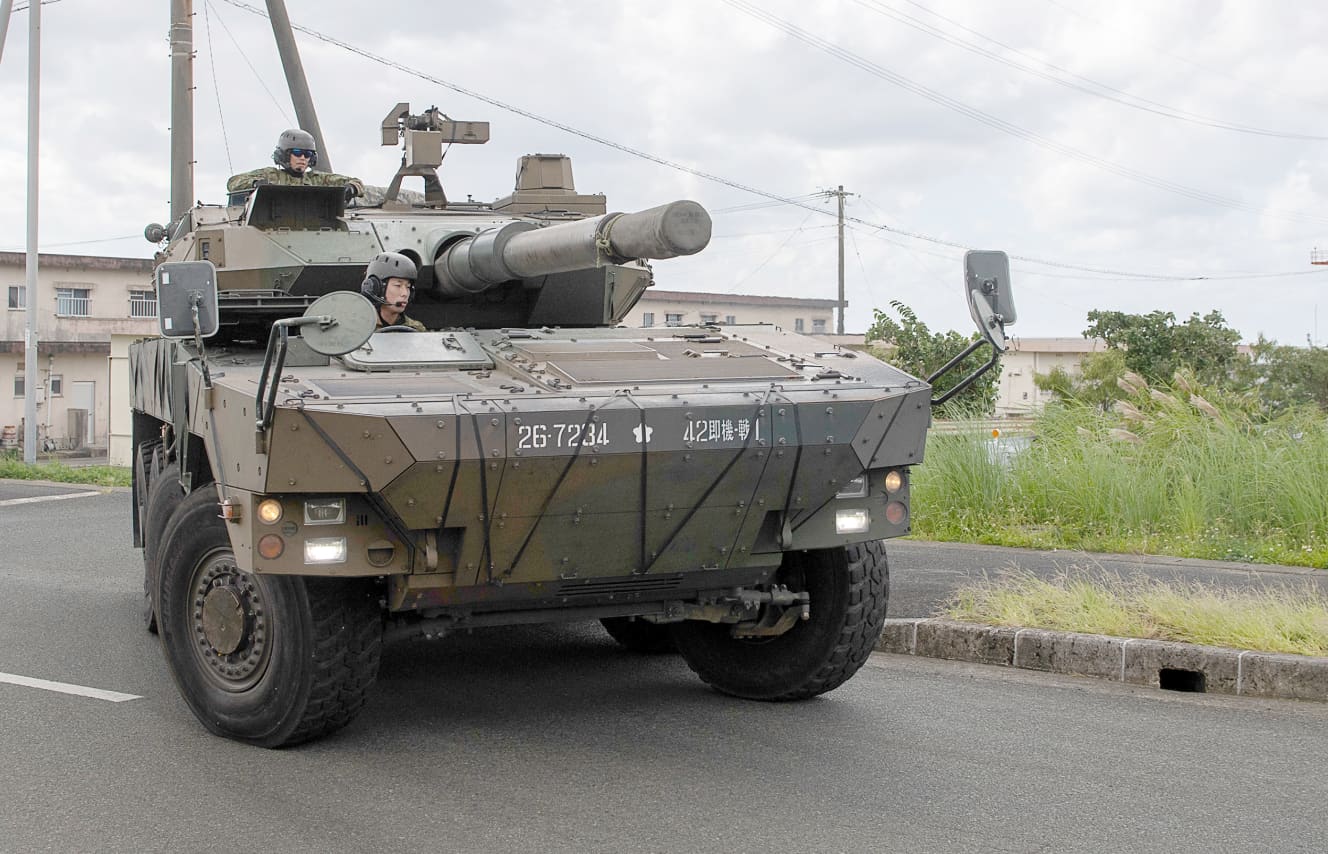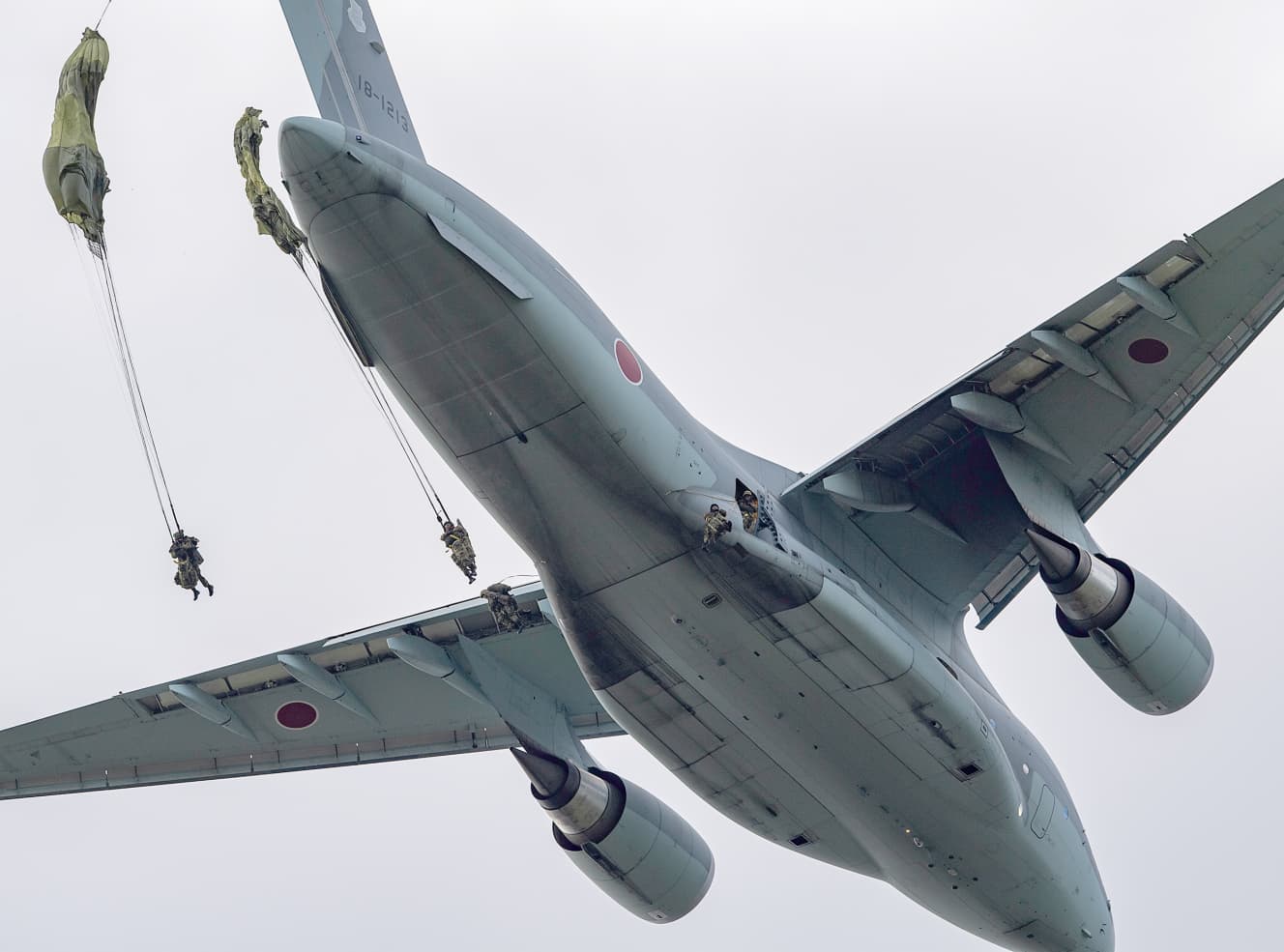Landing with amphibious vehicles, parachuting with paratroopers…Self-Defense Forces x U.S. Forces in Japan “The Japanese version of the Marine Corps: The power of the Marine Corps! The scene of a training exercise” spectacular photos
Prepare for Taiwan contingency! Over 40,000 personnel, 3,500 vehicles, 20 naval vessels, and more than 200 aircraft gathered on Tokunoshima Island, Kagoshima, etc.

The five AAV7 amphibious vehicles roar forward, cutting through the waves.
They stopped once offshore, lined up vertically in a single file, and then pushed forward in a single bound toward the beach. The speed was further increased, and after landing on the beach with a huge splash that almost covered the vehicle, the vehicle proceeded to the far end of the beach and came to a sudden halt. Immediately the rear hatch opened, and Self-Defense Force officers with rifles jumped out from inside.
At around 10:00 a.m. on November 19, an amphibious task force, Japan’s version of the Marines, organized by the Ground Self-Defense Force, successfully landed on Hanatoku Beach on Tokunoshima Island (Kagoshima Prefecture), which belongs to the Nansei Islands.
This was a scene from the “2023 Self-Defense Forces Integrated Exercise” held by the Self-Defense Forces from November 10 to 20, 2023.
The “integrated” in the name of the exercise refers to the operation of the Ground, Maritime, and Air Self-Defense Forces as a single unit. U.S. forces in Japan also participated in the exercise. In addition, trainees were invited from the ROK, the Philippines, and NATO.
The total number of SDF personnel who participated in the training was approximately 30,000, and the total number of personnel including those from the U.S. Forces in Japan was more than 40,000. In addition, approximately 3,500 vehicles, 20 naval vessels, and 210 aircraft participated, making this the largest training exercise of the year.
For the past several years, the SDF’s drills have been designed to defend the islands of Japan’s southwestern archipelago in response to China’s invasion of Taiwan. Once the Taiwan contingency becomes a reality, it is the islands of Okinawa and southern Kyushu, which are close to the “battlefield,” that will face the danger.
It is predicted that the main island of Okinawa, which will serve as a base for U.S. forces, will be hit by countless missiles, and that the Nansei Islands and remote islands of Okinawa, which will be exposed to Chinese forces when they land in eastern Taiwan, are likely to be invaded by Chinese forces.
In the past, training has been conducted on Tokunoshima Island, Amami Oshima Island, and remote islands in Okinawa Prefecture, but this year’s exercise focused on training on “fabrics” – places where the SDF would actually be deployed in the event of an emergency. Normally, SDF training is conducted on remote “training grounds,” but the island defense training focuses on special terrain and weather conditions such as the ocean, sandy beaches, and urban areas, which are not available on training grounds. In search of a “more realistic battlefield,” a huge drill was conducted for the first time on the entire island of Tokunoshima.
Prior to the start of the exercise, many units from Kyushu and other parts of Japan arrived on Tokunoshima one after another using Air Self-Defense Force transport planes and civilian ferries. They built positions in parks, grounds, and private land on the island.
At Cape Koibo, one of the scenic spots, Type 10 tanks were deployed and set their gun ports toward the enemy forces landing from the sea.
And a Type 16 mobile combat vehicle drove through the road in front of it.
V-22 Ospreys and other Ground Self-Defense Force air units landed at Teinohama Seaside Park and Tokunoshima Town Sports Park. As the author drove along the coastline in a rental car, the Maritime Self-Defense Force transport ships “Osumi” and “Shimokita” came into view.
The Air Self-Defense Force’s “Mobile and Distributed Operations” training was a particularly important part of the exercise. F-15 fighters and E-2C early warning aircraft flew touch-and-go and refueled at Tokunoshima and Amami airports.
As mentioned earlier, the assumed “situation where the Air Self-Defense Force base became unusable” was a case where “the runway of Naha Air Base was destroyed” by an air attack by enemy missiles, bombers, or bombings by armed operatives, etc. On November 15, the runway was repaired at Naha Air Base by the Ground and Air Self-Defense Force facility units. On November 15, the runway was repaired at Naha Air Base by the Ground Self-Defense Force and Air Self-Defense Force facility units.
Naha Air Base is the only Air Self-Defense Force base between Kyushu and Yonaguni Island, Japan’s westernmost island, where fighter jets can take off and land.
In the event of a preemptive attack on Naha Air Base, the SDF would have to use the civilian airports on Tokunoshima and Amami.

Co-starring the strongest units of the Ground Self-Defense Force
While the first half of the exercise focused on training to “defend the island,” the final phase of the exercise, held from the 18th to the 19th, was an exercise to “retake the island” on the assumption that the enemy forces had invaded and taken control of Tokunoshima.
The mission was to subdue the enemy hiding in the mountains near Tokunoshima Airport, and an amphibious task force was sent into the island from the sea using AAV7 amphibious vehicles and LCAC hovercraft transport boats loaded onto MSDF transport ships.
At the same time, C-2 and C-130 transport aircraft flew over the sugarcane fields in the Kaneku district in western Tokunoshima. The elite members of the 1st Airborne Paratroopers, the pride of the Ground Self-Defense Force’s elite unit, gave the signal and descended from an altitude of about 300 meters.
Up to six members equipped with Type 13 paratroopers took off at once. This was repeated several times. The elite parachutists who descended to the surface were hidden from view by the two-meter tall sugar cane.
However, from the sounds of their voices and footsteps, it was clear that the troopers were running through the sugar cane.
The roadside ditches in the vicinity were covered with white bed mattresses and road signs were covered with green blankets. The purpose was to lessen the impact of a fall or collision with a descending member of the team.
The climax of the exercise was a joint performance by the strongest units of the JSDF, known as “the Airborne in the East and the Waterborne in the West.
What made this large-scale, island-wide training possible? The main reason is the understanding of the three municipalities that make up Tokunoshima: Tokunoshima Town, Isen Town, and Amagi Town. The residents were so favorable that there was even talk of attracting Self-Defense Forces facilities.
The economic effect that the giant exercise will have on the town cannot be ignored. During the training period, the hotels on the island were fully booked. Rental cars were also full. Many of them were used by the Ministry of Defense. Gas stations in the city were lined with Self-Defense Forces vehicles to refuel.
During the parachute paratroopers’ descent training by the 1st Airborne Brigade, they had asked nearby farmers to move their cars and other vehicles to avoid accidents in case the parachutists landed outside the planned area, but residents were cooperative, with some parents and children saying they would observe the training with their children.
After landing, some islanders and couples looked at the AAV7 waiting on the beach from afar as if it were a rare sight. The number of galleries grew and grew.
After the exercise, when interviewed by the press, Yoshihide Yoshida, Chief of the Joint Staff, bowed his head and said, “I am very happy that we were able to conduct a dough exercise like this one.
I would like to thank the local governments of the three towns and the islanders for their deep understanding. I would like to express my gratitude.
Japan’s security environment is more critical than we can imagine. A senior Self-Defense Forces official went so far as to say, “It is more than the Cold War, and I would say it is the biggest crisis since the end of World War II.
Against this backdrop, Russia’s invasion of Ukraine, a war of aggression, has changed the color of the eyes of even the most peace-minded politicians. It is probably not unrelated to a sense of crisis that the islanders were cooperative in large-scale drills using the entire island.
For China, which has been advancing its hegemonic maritime expansion by building bases and airstrips in the South China Sea, Japan’s Southwestern Islands are a bump on the road to success. It will also serve as a barrier to blocking any exit when it ventures out into the Pacific Ocean.
The “time” is surely approaching, and the Self-Defense Forces cannot continue to conduct “water training on the tatami” as they have in the past.
One of the reasons for this is that the SDF is in a situation where it cannot continue with the same “water training on the tatami mats” as it has in the past. The SDF is now under pressure to step up its game.






From the December 8-15, 2023 issue of FRIDAY
Photography and text by: Masayuki Kikuchi